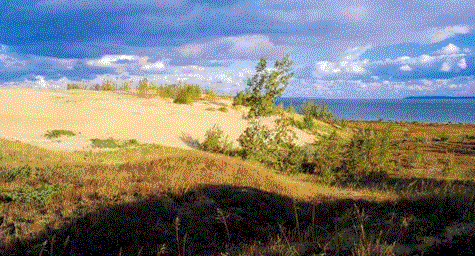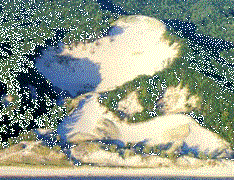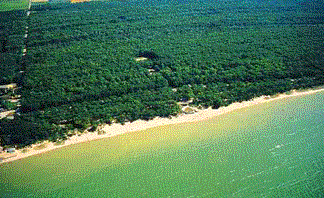DEFINITIONS OF THE DUNES
Coastal dunes differ sharply from arid dunes. Due to
wave action and vegetation dunes in coastal areas are unique.
Some of the most common formations are dune
ridges, perched, parabolic and linear dunes.
 One of the most famous perched
dunes on Lake Michigan rises 450 feet above the lake. It
is actually a modest-sized wind-formed dune that is "perched"
atop a glacial moraine. Onshore winds have lifted sand up the
slope and collected it in these dunes.
One of the most famous perched
dunes on Lake Michigan rises 450 feet above the lake. It
is actually a modest-sized wind-formed dune that is "perched"
atop a glacial moraine. Onshore winds have lifted sand up the
slope and collected it in these dunes.
 Parabolic dunes are U-shaped
and found only in humid coastal areas and never in arid regions.
The are made when the stabilizing plant cover of a linear dune
is destroyed exposing the sand to the wind. A ridge, often referred
to as a blowout is then pushed into the dune beyond. The dune
appears stacked. The marram grass allows the height to reach 250
to 300 feet.
Parabolic dunes are U-shaped
and found only in humid coastal areas and never in arid regions.
The are made when the stabilizing plant cover of a linear dune
is destroyed exposing the sand to the wind. A ridge, often referred
to as a blowout is then pushed into the dune beyond. The dune
appears stacked. The marram grass allows the height to reach 250
to 300 feet.
 Linear dunes are ridges
generally parallel to the shoreline. They rarely are higher than
30 to 50 feet and the most common dune near the water.
Linear dunes are ridges
generally parallel to the shoreline. They rarely are higher than
30 to 50 feet and the most common dune near the water.
 The process of one plant community replacing another
over time very visible at the dunes. This process is called succession. Great
Lakes coastal dunes can be divided into four distinct areas. The
basis for the division is the presence of particular plant and
animal species commonly associated with certain land features.
Some animals inhabit more than one area depending upon their habits
or the season.
The process of one plant community replacing another
over time very visible at the dunes. This process is called succession. Great
Lakes coastal dunes can be divided into four distinct areas. The
basis for the division is the presence of particular plant and
animal species commonly associated with certain land features.
Some animals inhabit more than one area depending upon their habits
or the season.
 Succession in the foredune begins
with the pioneer grasses. The fibrous root systems grow rapidly, binding
sand together and stabilizing the dune. Plants of the foredune
specially adapted to the low fertility and lack of moisture.The
pitcher's thistle grows only in undisturbed dunes of the upper
Great Lakes. In summer, daytime temperatures can reach as high
as 120 degrees which causes may animals to burrow. At night in
the cooler temperatures, Fowler's toads, the eastern hognose snake
and wolf spiders come out.
Succession in the foredune begins
with the pioneer grasses. The fibrous root systems grow rapidly, binding
sand together and stabilizing the dune. Plants of the foredune
specially adapted to the low fertility and lack of moisture.The
pitcher's thistle grows only in undisturbed dunes of the upper
Great Lakes. In summer, daytime temperatures can reach as high
as 120 degrees which causes may animals to burrow. At night in
the cooler temperatures, Fowler's toads, the eastern hognose snake
and wolf spiders come out.
 The sheltered area between the
foredune and the backdune is a low area called a trough or interdunal
pond. The water in these depressions is the result of fluctuating
lake levels. Ponds may even disappear in years of lower lake levels.
In addition to dune plants and animals, interdunal ponds provide
a sheltered aquatic habitat for wetland species.
A short distance away from the
foredune and the trough is the forested backdune.
Shade tolerant plants such as mosses
and ferns live on north facing slopes. South facing slopes provide
nurishment for spring wildflowers and tree seedlings.
A blowout
may occur when dune grass is altered
by natural or artificial means. Blowout begin when even a small
amount of vegetation is removed. As the wind lifts the sand grain
by grain, the grasses and trees are undercut, sometimes all the
way to the hardwoods of the backdune. The grasses may soon grow
back, but the trees take hundreds of years or more to return.
Sand dunes illustrate the crucial
interrelationships of living things to their environment. In the
late 1800's Dr. Henry Cowles, professor of biology at the University
of Chicago focused on the Indiana Dunes as an outdoor laboratory.
Cowles noted how dunes eveolve from sane to ridges of pioneer
grasses (marram and sand reed grasses). Over time shrubs like
dogwood begin to grow. This is followed by cottonwood trees. Eventually
these plants are replaced until the forest reaches maturity and
is known as the climax forest.
The sheltered area between the
foredune and the backdune is a low area called a trough or interdunal
pond. The water in these depressions is the result of fluctuating
lake levels. Ponds may even disappear in years of lower lake levels.
In addition to dune plants and animals, interdunal ponds provide
a sheltered aquatic habitat for wetland species.
A short distance away from the
foredune and the trough is the forested backdune.
Shade tolerant plants such as mosses
and ferns live on north facing slopes. South facing slopes provide
nurishment for spring wildflowers and tree seedlings.
A blowout
may occur when dune grass is altered
by natural or artificial means. Blowout begin when even a small
amount of vegetation is removed. As the wind lifts the sand grain
by grain, the grasses and trees are undercut, sometimes all the
way to the hardwoods of the backdune. The grasses may soon grow
back, but the trees take hundreds of years or more to return.
Sand dunes illustrate the crucial
interrelationships of living things to their environment. In the
late 1800's Dr. Henry Cowles, professor of biology at the University
of Chicago focused on the Indiana Dunes as an outdoor laboratory.
Cowles noted how dunes eveolve from sane to ridges of pioneer
grasses (marram and sand reed grasses). Over time shrubs like
dogwood begin to grow. This is followed by cottonwood trees. Eventually
these plants are replaced until the forest reaches maturity and
is known as the climax forest.






